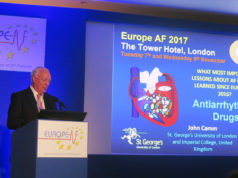
Preliminary results of a new multicentre study have found that both paroxysmal and persistent atrial fibrillation may be sustained by localised stable rotors and that targeted ablation of those sources by focal impulse and rotor mapping (FIRM) can eliminate atrial fibrillation
Data of the Multicenter Validation of FIRM Ablation for Atrial Fibrillation trial were presented by investigator John M Miller (director, Clinical Cardiac Electrophysiology, Indiana University School of Medicine, Indianapolis, USA) at the American Heart Association’s Scientific Sessions (AHA, 16–20 November, Dallas, USA).
Miller told delegates that the aim of this trial was to validate, with a multicentre study, results previously reported of a single centre experience in San Diego, USA, the CONFIRM (Conventional ablation for atrial fibrillation with or without focal impulse and rotor modulation) trial (J Am Coll Cardiol. 2012;60(7):628–636). CONFIRM showed that atrial fibrillation is often maintained by rotors or focal sources and that ablation of these sources can eliminate atrial fibrillation. Fifty six per cent of patients terminated atrial fibrillation with FIRM and two thirds of these patients had persistent atrial fibrillation.
In the multicentre study, 11 centres from different cities across the USA enrolled 210 patients with atrial fibrillation. Of those, 132 patients underwent FIRM-guided ablation then pulmonary vein isolation. At AHA, Miller presented results of 78 patients (San Diego area patients were not included in this analysis) and compared data with 71 control patients of the CONFIRM trial.
Miller said that baseline characteristics were similar in the FIRM-guided external validation group compared with the control patients in the CONFIRM study. The average age was 61 years in both groups, most patients had persistent atrial fibrillation in both groups (70.5% for the FIRM-guided external validation group and 66% for the controls in CONFIRM). The only significant difference, Miller noted, was that more patients had prior amiodarone in CONFIRM (38%) compared with the FIRM-guided external validation group (15.4%).
Atrial fibrillation was recorded with 64 pole basket catheters and mapped with RhythmView (Topera).
In this multicentre trial, Miller told delegates, focal sources with FIRM were localised in 100% of the patients (n=78), each exhibiting 2.3±0.9 concurrent sources, and 41% of the patients showed termination of atrial fibrillation to sinus rhythm. These results, in centres new to FIRM, Miller noted, are “very similar” as in the original CONFIRM trial, which found focal sources with FIRM in 97% of the patients, each exhibiting 2.1±1.0 concurrent sources, and termination of atrial fibrillation to sinus rhythm in 56% of the FIRM-guided patients. The total ablation time was roughly similar in both groups (16.6±11.7min for the FIRM-guided external validation group and 16.1±9.8min for the controls in CONFIRM).
In conclusion, Miller said: “Human paroxysmal and persistent atrial fibrillation seem to be sustained by localised stable rotors, ablation of which sites by targeted ablation using FIRM can accurately eliminate atrial fibrillation and result in sustained freedom from the arrhythmia.”
He added, “The learning curve for FIRM mapping and ablation is relatively rapid and multicentre randomised trials are underway.”












